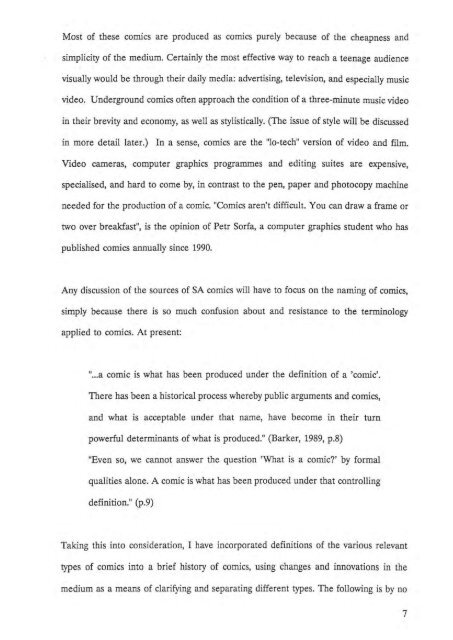Text - Rhodes University
Text - Rhodes University
Text - Rhodes University
Create successful ePaper yourself
Turn your PDF publications into a flip-book with our unique Google optimized e-Paper software.
Most of these comics are produced as comics purely because of the cheapness and<br />
simplicity of the medium. Certainly the most effective way to reach a teenage audience<br />
visually would be through their daily media: advertising, television, and especially music<br />
video. Underground comics often approach the condition of a three-minute music video<br />
in their brevity and economy, as well as stylistically. (The issue of style will be discussed<br />
in more detail later.) In a sense, comics are the "la-tech" version of video and film.<br />
Video cameras, computer graphics programmes and editing suites are expensive,<br />
specialised, and hard to come by, in contrast to the pen, paper and photocopy machine<br />
needed for the production of a comic. "Comics aren't difficult. You can draw a frame or<br />
two over breakfast", is the opinion of Petr Sorfa, a computer graphics student who has<br />
published comics annually since 1990.<br />
Any discussion of the sources of SA comics will have to focus on the naming of comics,<br />
simply because there is so much confusion about and resistance to the terminology<br />
applied to comics. At present:<br />
"... a comic is what has been produced under the definition of a 'comic'.<br />
There has been a historical process whereby public arguments and comics,<br />
and what is acceptable under that name, have become in their turn<br />
powerful determinants of what is produced." (Barker, 1989, p.8)<br />
"Even so, we cannot answer the question 'What is a comic?' by formal<br />
qualities alone. A comic is what has been produced under that controlling<br />
definition." (p.9)<br />
Taking this into consideration, I have incorporated definitions of the various relevant<br />
types of comics into a brief history of comics, using changes and innovations in the<br />
medium as a means of clarifying and separating different types. The following is by no<br />
7
















